Staff of the Henry R. Winkler Center for the History of the Health Professions
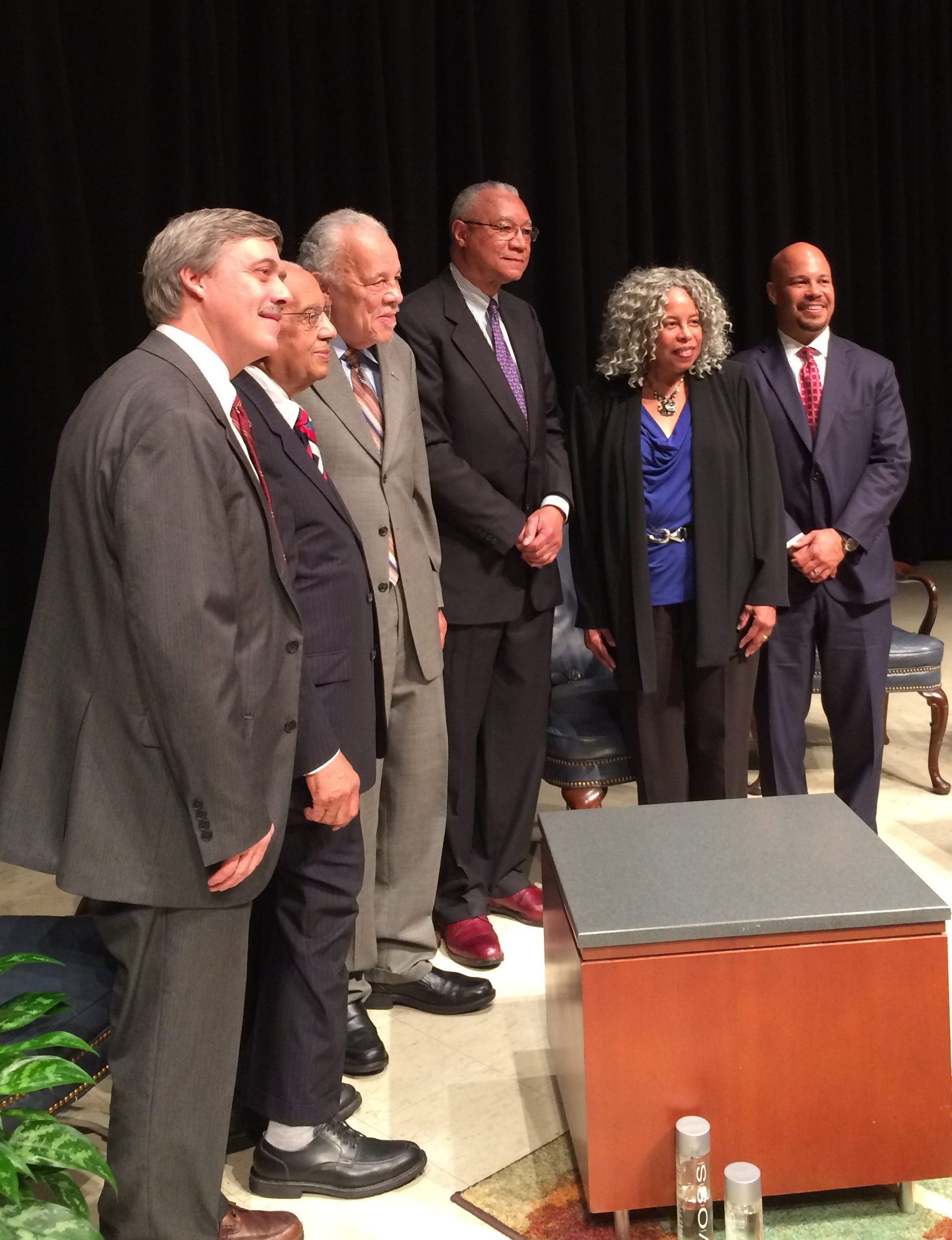
L to R, Drs. Philip Diller, Chester Pryor, Charles Dillard, Elbert Nelson, Camille Graham, Christoper Lewis
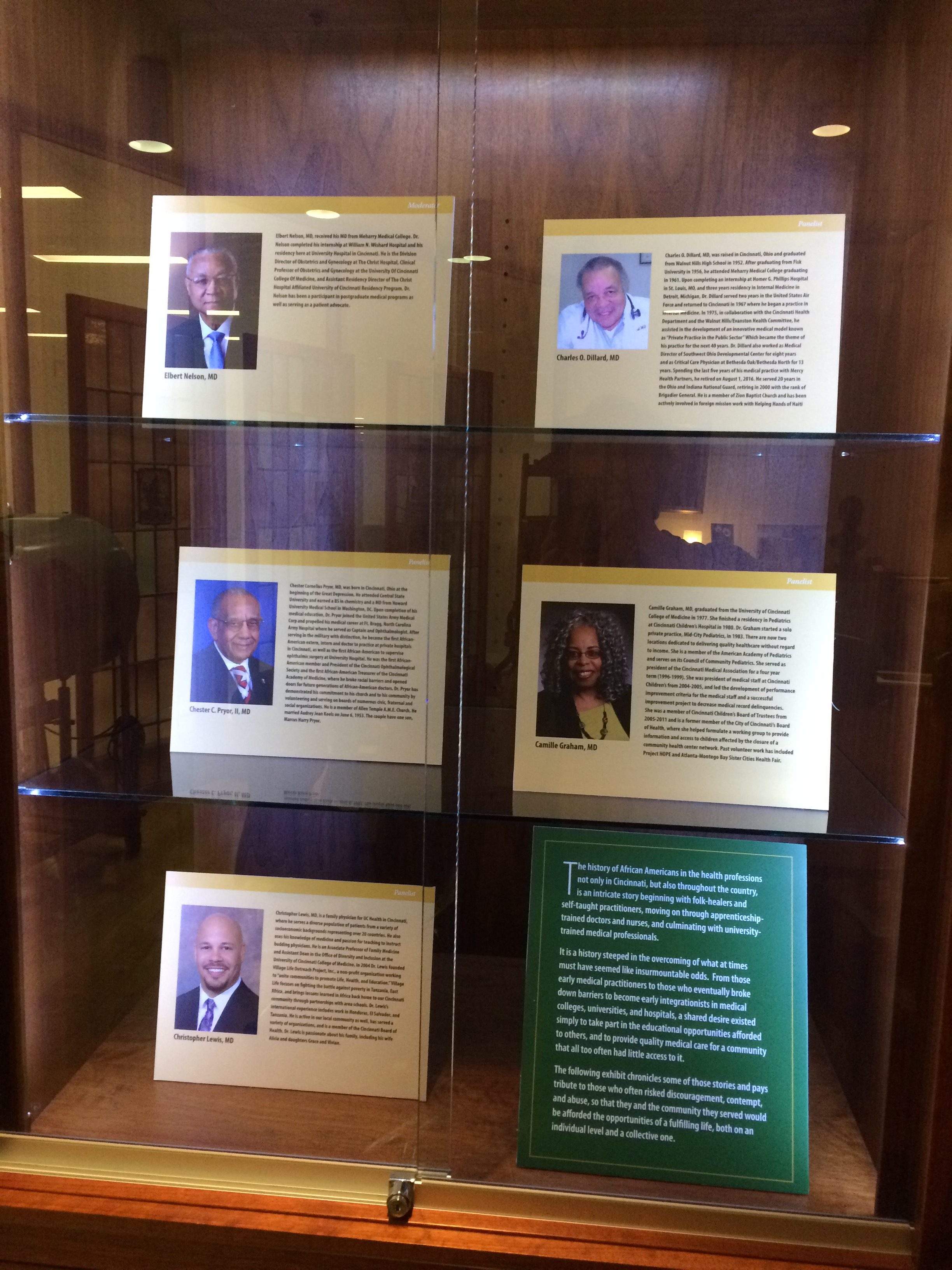
Panelist Bios
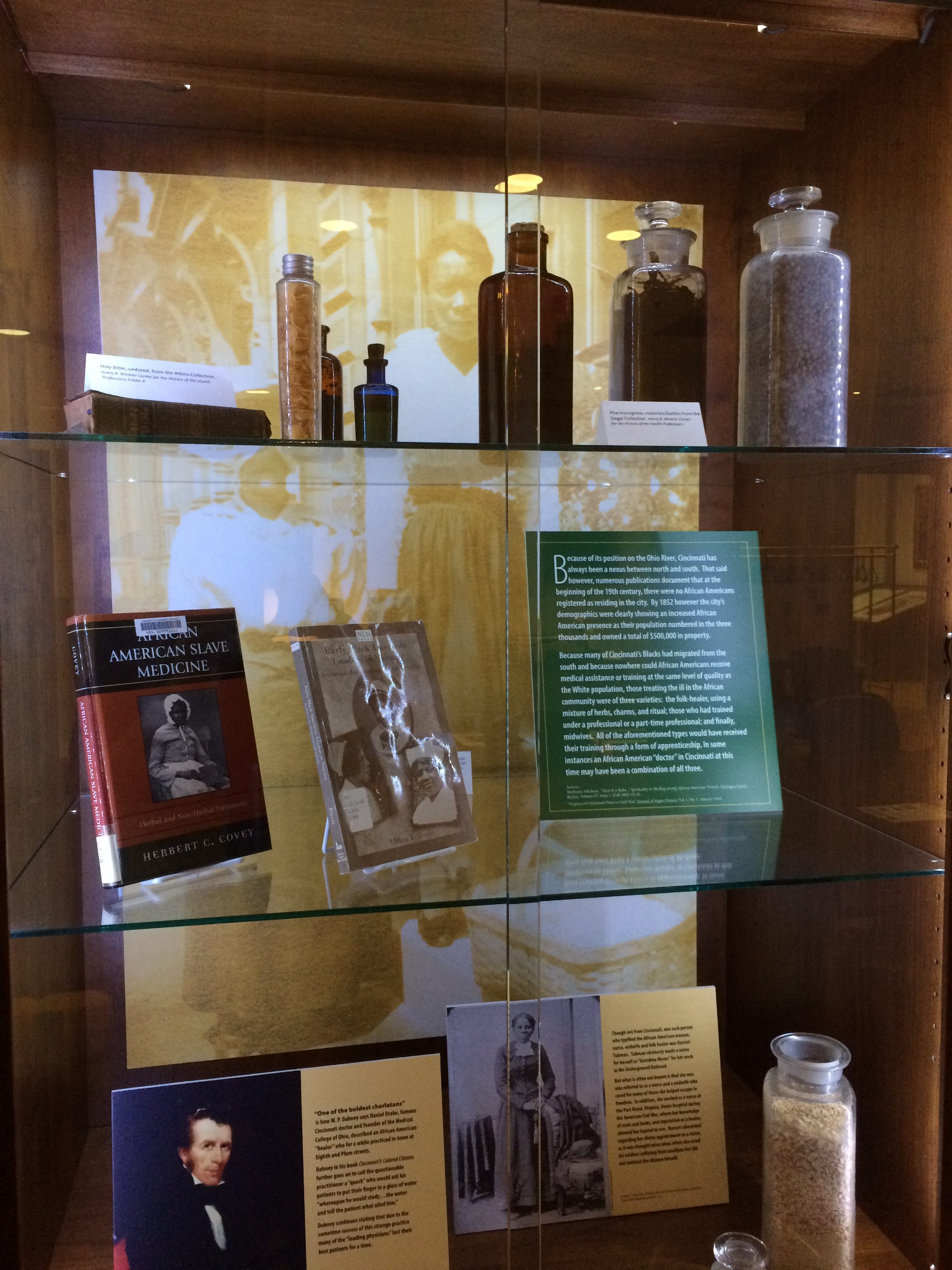
Exhibit Panels

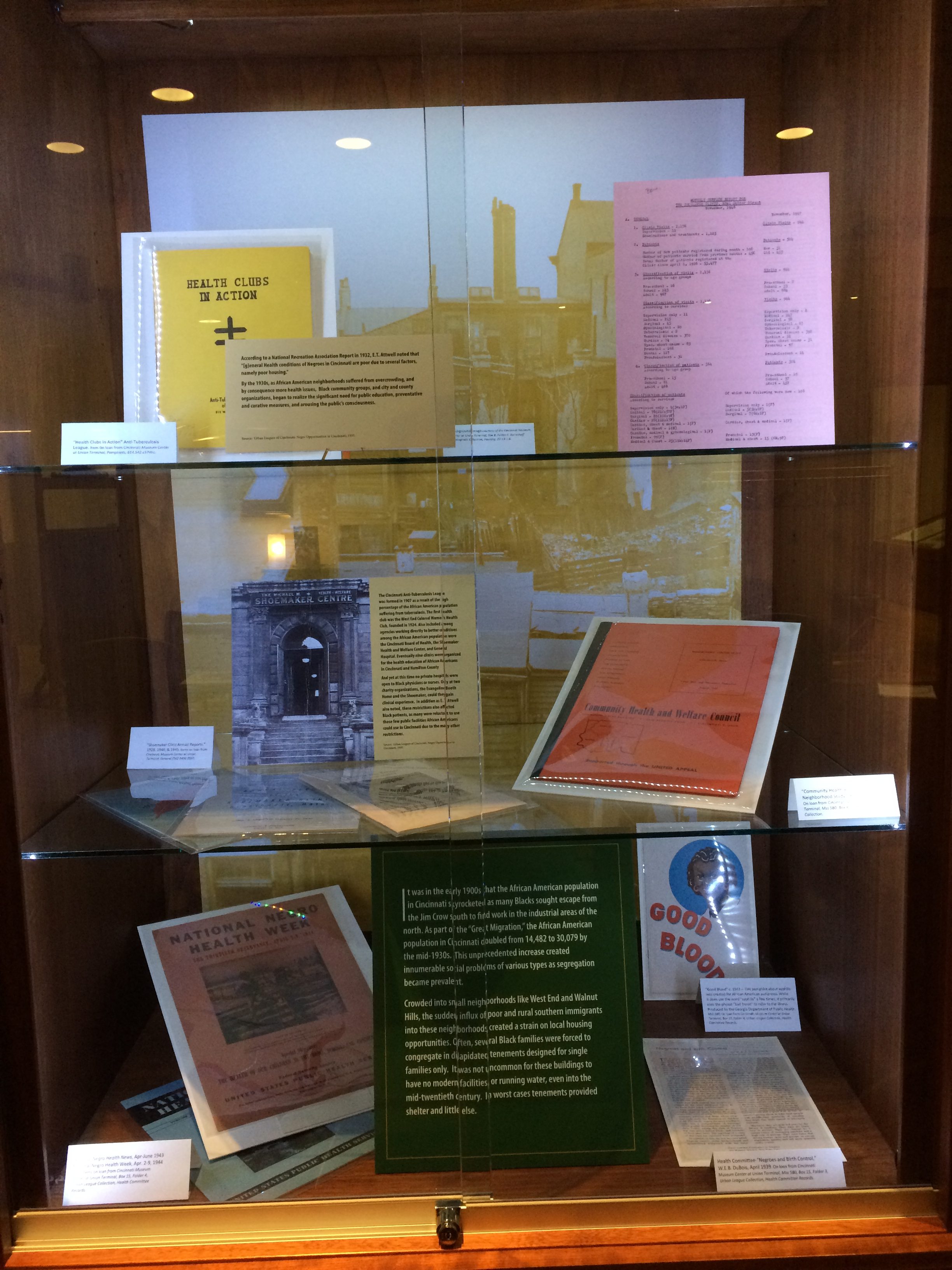
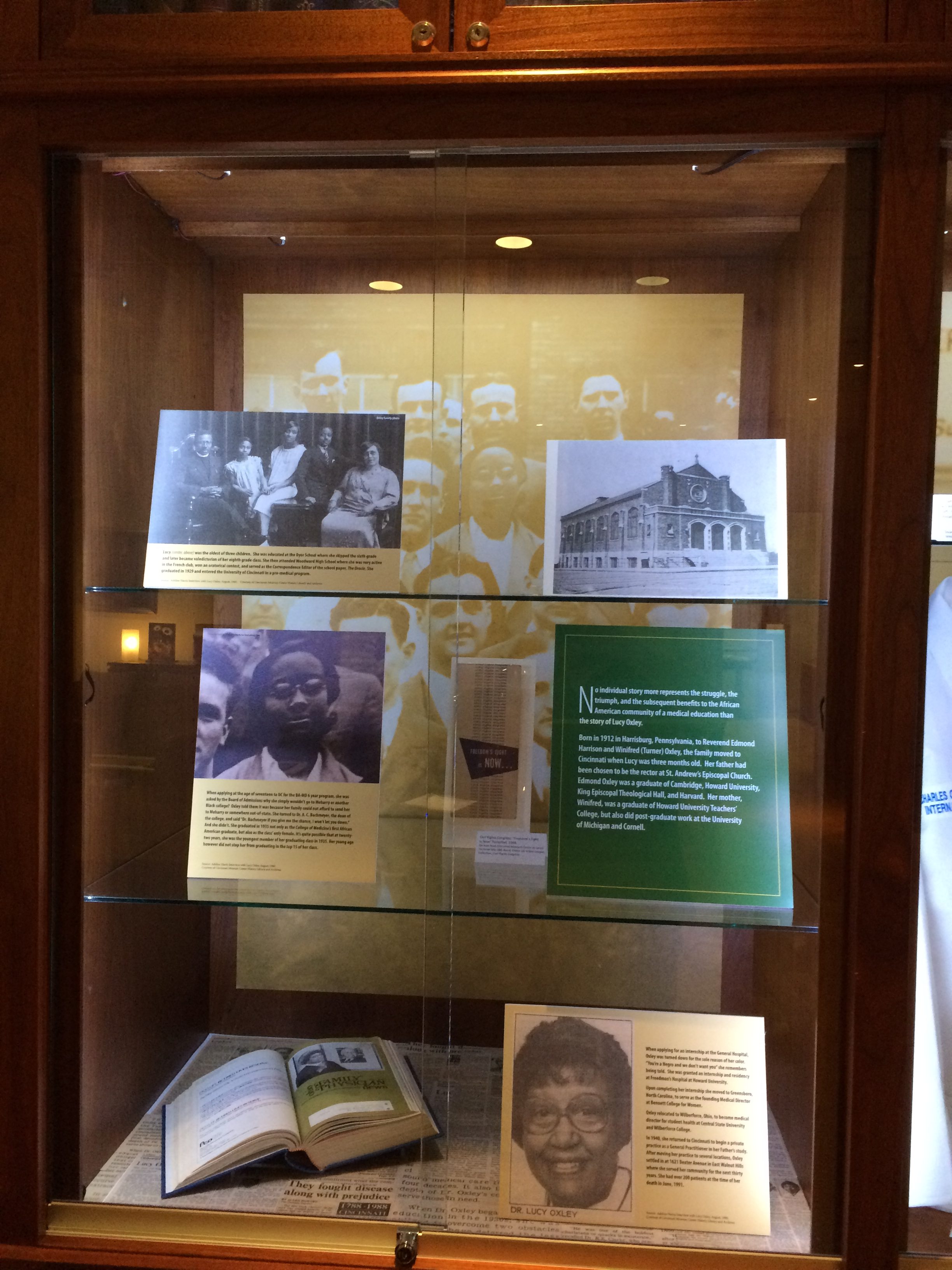
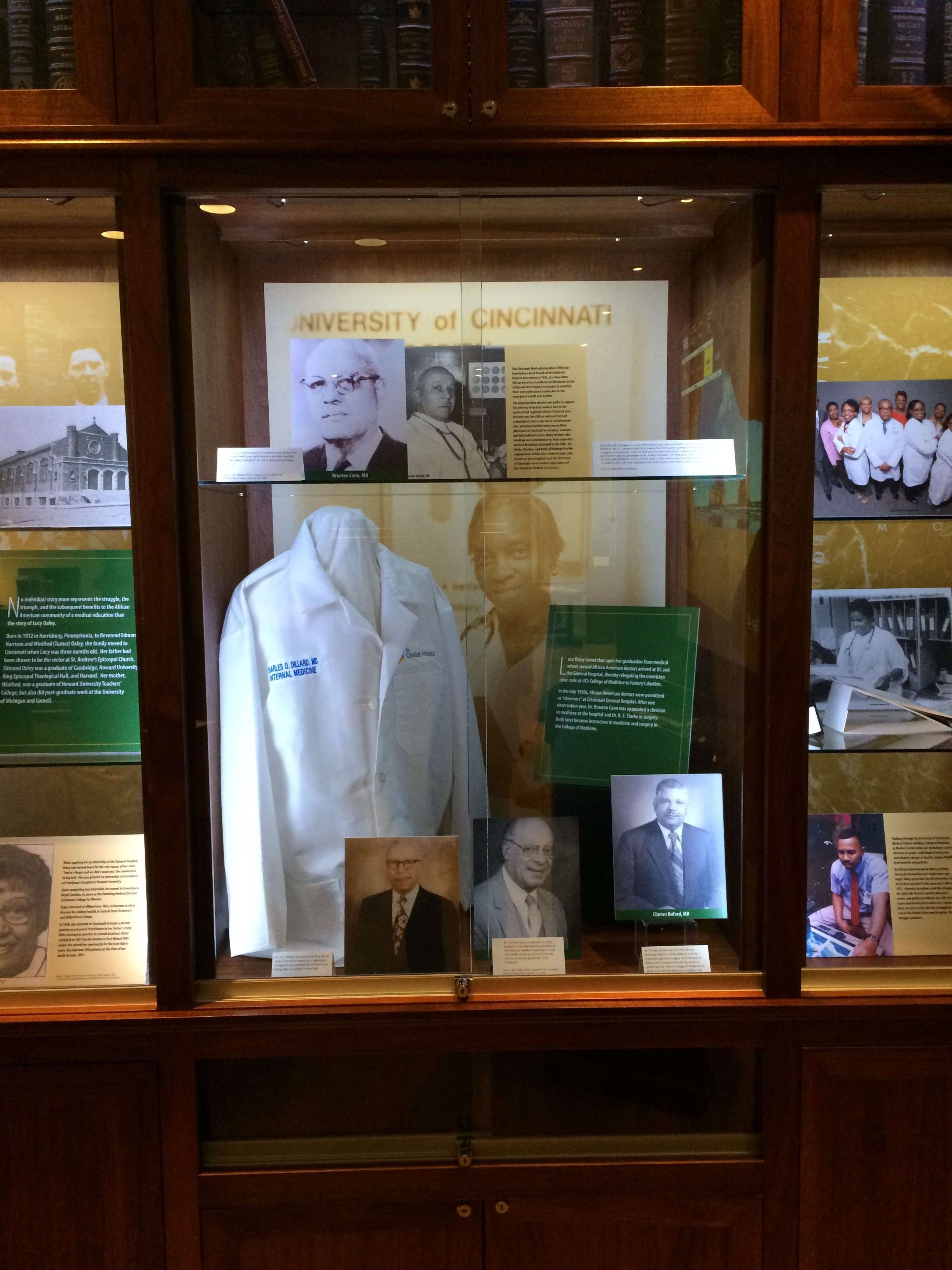
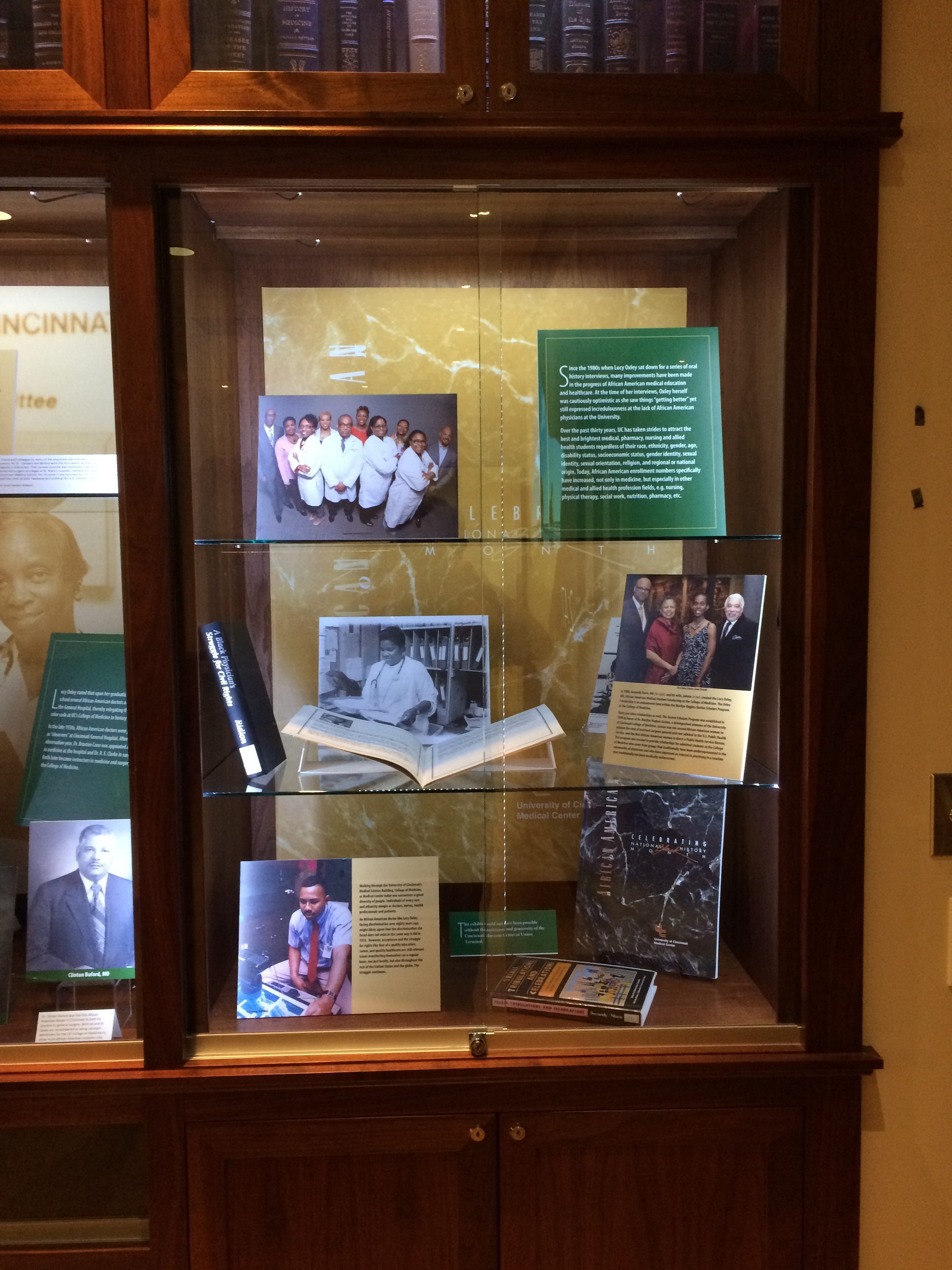
Exhibit Panel

Staff of the Henry R. Winkler Center for the History of the Health Professions

L to R, Drs. Philip Diller, Chester Pryor, Charles Dillard, Elbert Nelson, Camille Graham, Christoper Lewis

Panelist Bios

Exhibit Panels





Exhibit Panel
The Henry R. Winkler Center for the History of the Health Professions and the University of Cincinnati Libraries are proud to sponsor the 2017 annual Cecil Striker Lecture and exhibit. This year the program is entitled African American Physicians in Cincinnati: Past, Present & Future and features an inter-generational panel discussing challenges faced in the early integration of all-White hospitals and medical colleges, holding those doors open for others, the current state of African American physicians, and many other topics.
A corresponding exhibit chronicling the history not only of African Americans in the health professions in Cincinnati, but also, the history of health care opportunities for African Americans in the city opens on the same date.
We hope you can make it for this enlightening discussion and exhibit. Click on the invitation at right for more information and to RSVP.
In the meantime enjoy some images from the exhibit.
Huh?
A researcher recently asked if we had any images of the first building to house the Medical College of Ohio. Turns out we do not. Or if we do, we’re not sure where to find them. That said, we did find a beautiful image of the Medical College when it was on Sixth Street near Vine in downtown Cincinnati.
Daniel Drake founded the Medical College of Ohio in 1819 in Cincinnati and it has the distinction of being the oldest medical college west of the Allegheny Mountains. In addition, it is the second-oldest public college of medicine in the United States. The first classes at the college were held above a pharmacy reportedly owned by Drake himself. Drake left the school in 1823 and a series of different locations for the college followed.
In 1852, the college built on property it had purchased on Sixth Street and it would stay at this new address for the next forty-four years. As many already know, the Medical College of Ohio eventually became, along with the Miami Medical College, the College of Medicine at the University of Cincinnati.
So that ‘s the very brief story of the school depicted in the photograph, but what about the image itself. At least for us at the Winkler Center it is rare to come across a photograph this old with so much color. Unfortunately the image is in a very nice frame along with two other images pertaining to Drake. Since we are unaware of the item’s provenance we are reluctant to remove the images from the frame. If we could, it would be easy to see what kind of image specifically it is.
As the Archivist/Curator here, I am by no means an expert on photographic processes of the 19th century, so I consulted with some friends who are. The answers I have been given are:
A) If the photo is post-1880s, it could be a hand-colored silver gelatin print. Under a microscope I would see no paper fibers in the photo. For more info on silver gelatin prints see http://www.graphicsatlas.org/guidedtour/?process_id=337.
If it was done prior to 1880, say during the 1870s, it could be a printing process that was hand colored. Under magnification perhaps we would see the worm like pattern of the collotype print. http://www.graphicsatlas.org/guidedtour/?process_id=168? Or maybe a letterpress halftone checkered pattern.(http://www.graphicsatlas.org/guidedtour/?process_id=102)?
Regardless, it looks like we won’t find out until we remove it from the frame and put it under a microscope. In the meantime we’ll just enjoy it for what it is, a great, colorful piece of history. We’ll keep you posted.
Not much I can assure you. That said, recently we were performing a large scale book move to make room for newly cataloged monographs when I stumbled upon the book in the image below.

Vitalogy by E. H. Ruddock, M. D.
It was the cover that caught my eye because it seemed immediately familiar. Within a split second I realized that the cover of the book in question looked exactly like the cover of my favorite album by the band Pearl Jam.
Wait a second? “Who’s Pearl Jam” you may be asking yourself. That’s OK. They are a rock and roll band from Seattle that broke around 1992. Released on Epic Records in the fall of 1994,Vitalogy was the band’s third album. And as I’ve just found out, the title of a book.
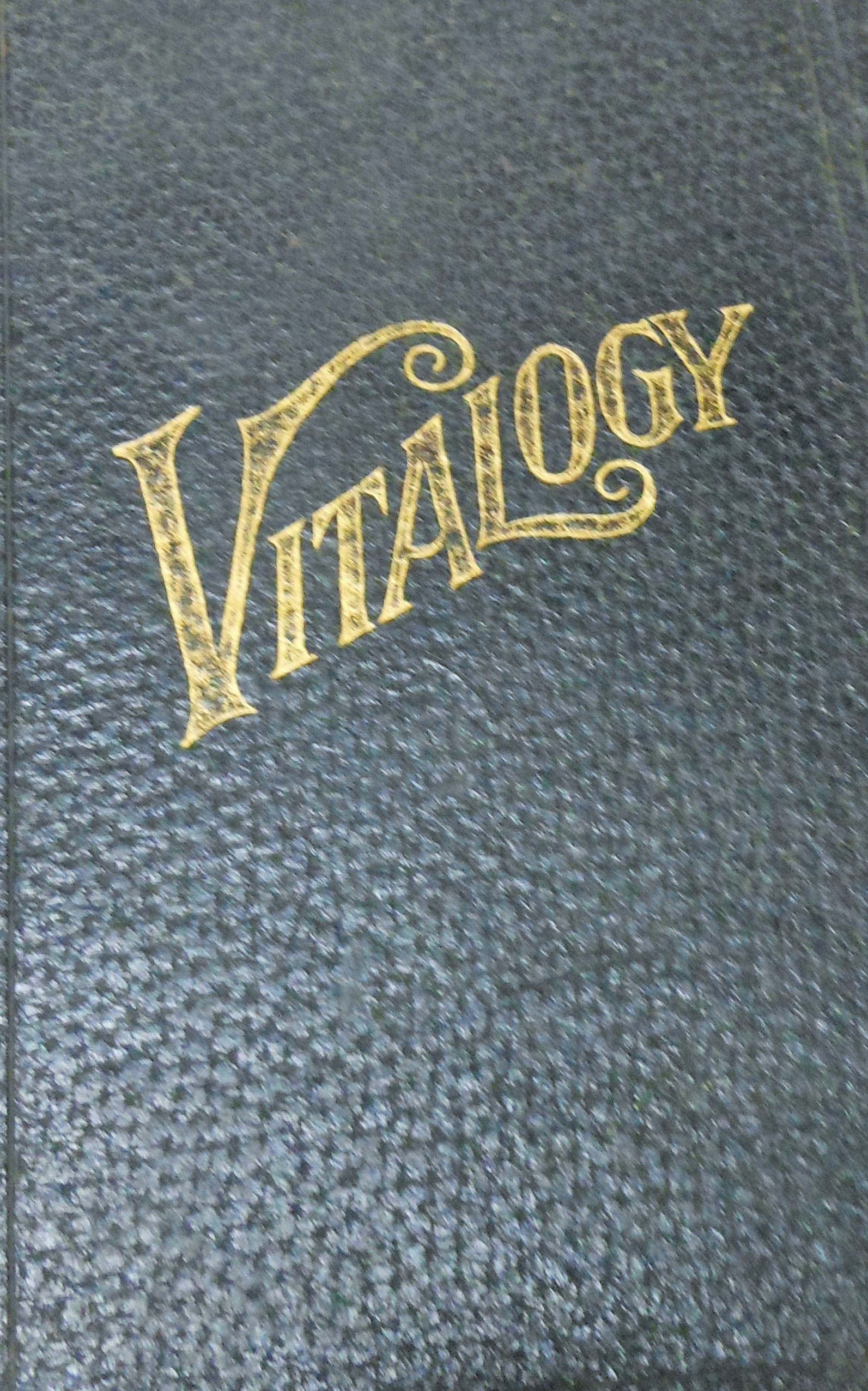
Vitalogy Cover
I didn’t know it when the record was released, but the band chose the title because the lead singer/songwriter of the group, Eddie Vedder, saw the volume at a garage sale, liked it’s title, design, font, etc., and purchased it. He later showed it to the rest of the band and it soon became the title of the new album. The Vitalogy album/CD cover mimicked the cover of the book and original text from the book was used to populate the album’s liner notes.
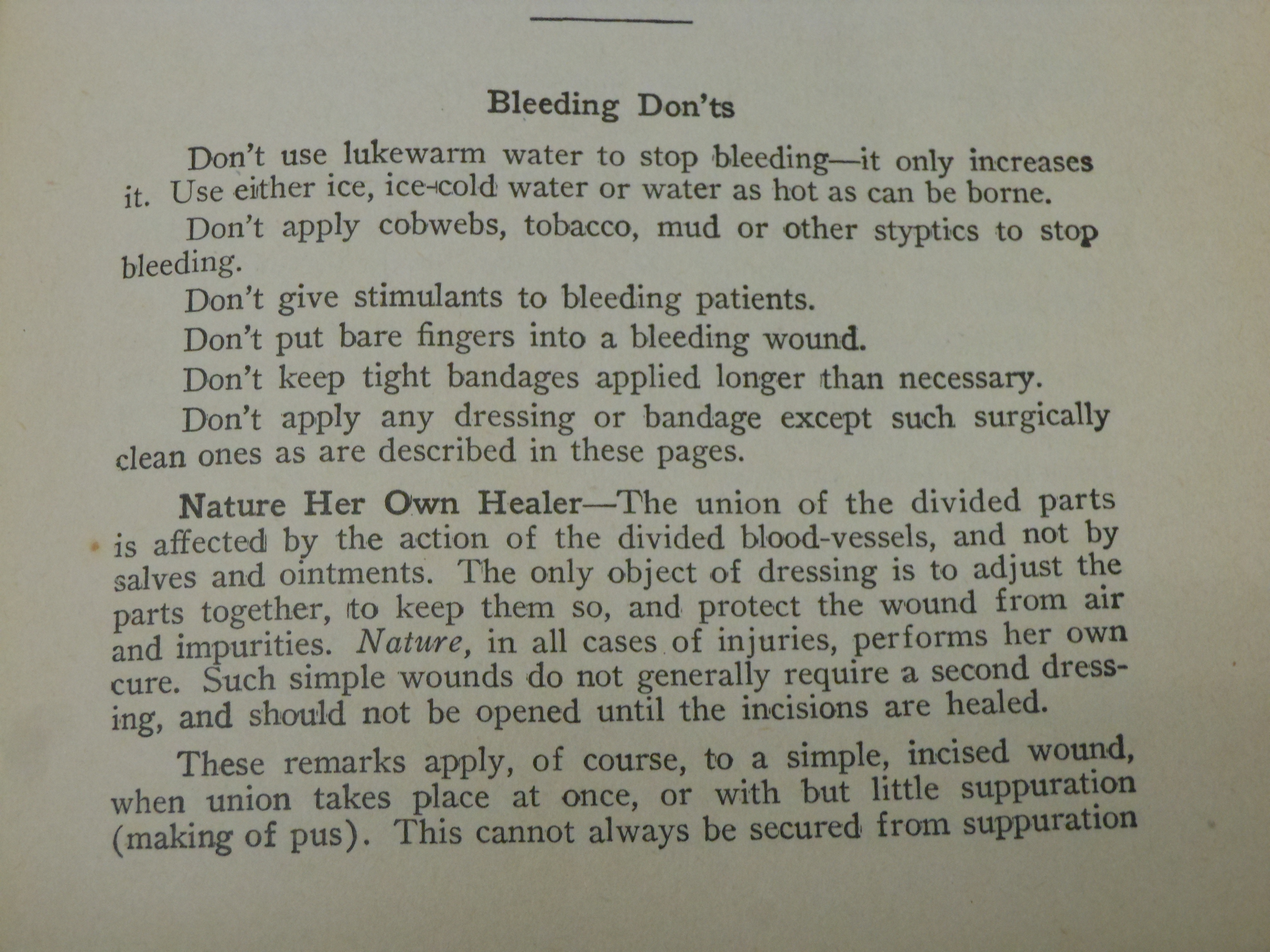
Text
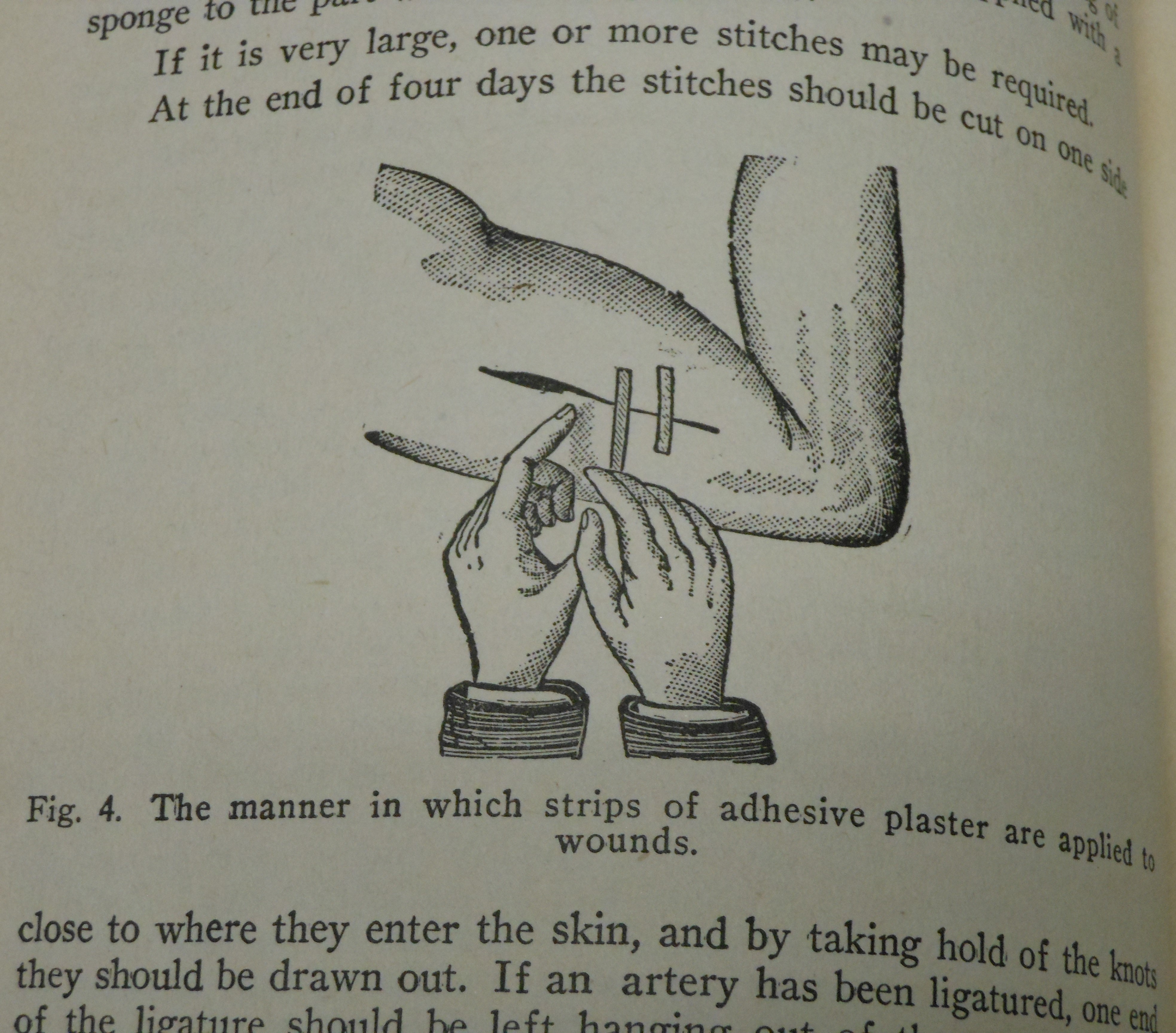
Textual diagram
So what about the book? Vitalogy, An Encyclopedia of Health and 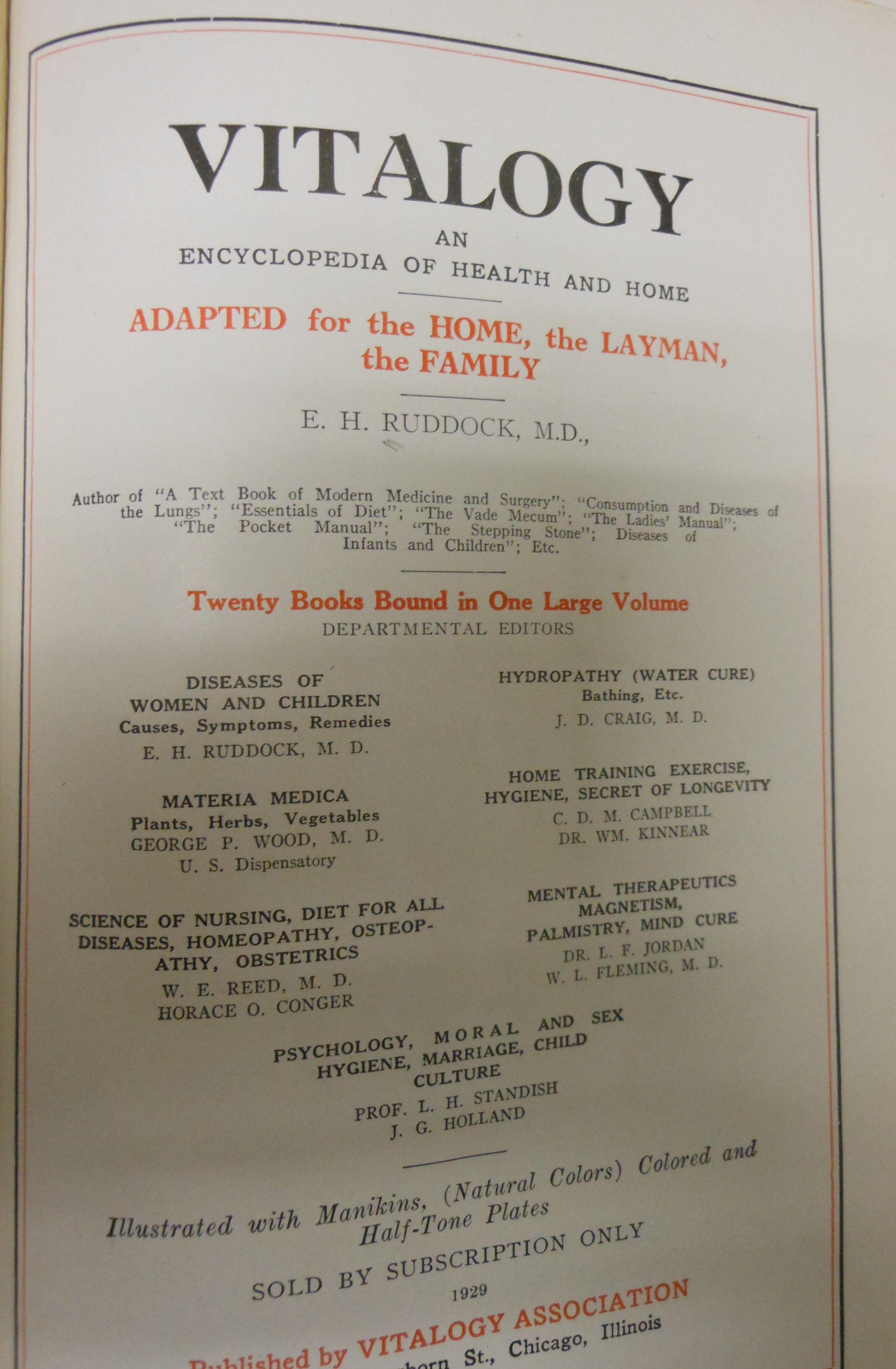 Home Adapted for the Home, the Layman, and the Family by E. H. Ruddock, M.D. was first published in 1899; the edition we have is from 1926. Biblical in proportion it contains 1004 pages full of holistic cures, medical advice and proverbial wisdom. In addition, it is full of incredibly detailed and intricate color illustrations and fold outs.
Home Adapted for the Home, the Layman, and the Family by E. H. Ruddock, M.D. was first published in 1899; the edition we have is from 1926. Biblical in proportion it contains 1004 pages full of holistic cures, medical advice and proverbial wisdom. In addition, it is full of incredibly detailed and intricate color illustrations and fold outs.

Example of some of the detailed color foldouts
Glancing through its pages, one can imagine Vitalogy at home in any aisle of a Whole Foods or a Sprouts Market–the book that is, though I’m sure the album would do well there too.
Below is the Save the Date for the Winkler Center’s Cecil Striker Annual Lecture. The lecture is titled African American Physicians in Cincinnati: Past, Present and Future and will focus on the contributions, challenges and professional achievements of African American health care professionals from the University of Cincinnati as well as the Cincinnati region. This year instead of one lecturer we will feature a panel of four individuals who are retired or current African American physicians. The Henry R. Winkler Center Advisory Board Members, as well as faculty and staff of the Winkler Center are very excited about this upcoming event. 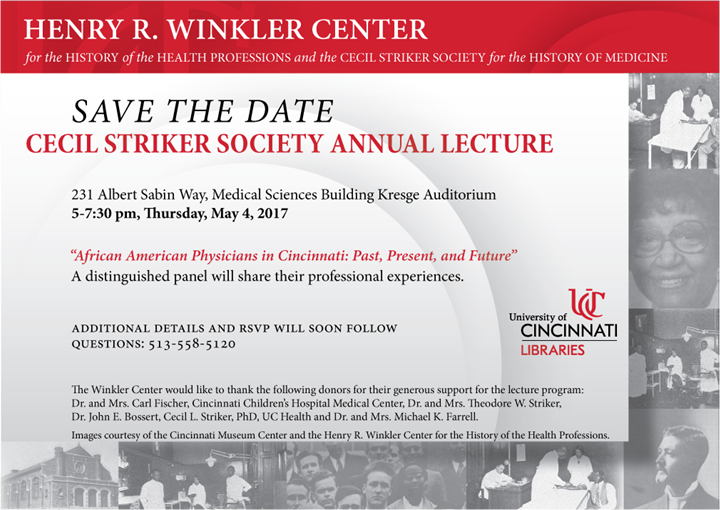
The following post was written by Winkler Center assistant archivist, Nina Herzog. All images courtesy of the Henry R. Winkler Center for the History of the Health Professions
Without a doubt, checking into and staying at hospitals is a lot different today than it was over a half century ago. Computerized check-ins, televisions in rooms and bans on smoking, etc. have all improved the patient experience. The images below were taken from an informational booklet given to patients at the Cincinnati General Hospital (CGH) in 1958.
The instructive pamphlet titled, “Well Here I Am,” provides the incoming patient with information on subjects ranging from check in, dining hours, and visitor information to hospital maps, directions, and much more.

This gallery contains 7 photos.
The Winkler Center was saddened over the weekend to learn of the passing of Dr. Henry J. Heimlich. In lieu of writing another obituary or quick biography like the ones that can be read here at the Cincinnati Enquirer or … Continue reading
Recently, Smithsonian.com published a brief article on the history of leaded

Dr. Robert Kehoe, Kettering Laboratory, UC, date unknown
gas. The article, seen here, http://www.smithsonianmag.com/smart-news/leaded-gas-poison-invented-180961368/, is informative though by no means exhaustive. The story begins in 1920, 55 miles up I-75, in Dayton, Ohio, at the General Motors Research Corporation. An engineer there, Thomas Midgely, and his boss, Charles F. Kettering, had developed an anti-engine knock additive called TEL or tetraethyllead.
At the time, “engine knock,” which was due to a malfunction between the fuel, air, and ignition explosion in a car’s cylinder, was at best a mild annoyance causing a light knocking sound and at worst a problem capable of destroying an automobile engine. Midgely’s solution was to add TEL to gasoline which would raise the combustability, or octane, of an engine lessening its chances of malfunctioning.
It worked. Which was all well and good, but TEL contained lead, and as people have known for ages, lead isn’t particularly good for us. In fact it’s rather deadly. The author goes on to discuss the outcry that erupted after several workers died after being exposed to TEL on a regular basis. A federal study was authorized in 1925 and it was decided that the amount of risk associated to every day exposure for most people was minimal and the production of leaded gasoline continued. It was not until the 1970s that growing evidence over leaded gas’s danger became evident. In January, 1996, the U.S. Clean Air act, officially banned the sale of leaded fuel for use in vehicles. Continue reading
Thursday, October 27, marks the 100th anniversary of the birth of Dr. Henry R. Winkler. Winkler served as President of the University of Cincinnati from 1977 to 1984. Among the 29 presidents who have stood at the helm of the University, Winkler remains the only one who also was an alumnus.
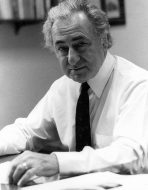
Henry R. Winkler, UC, c. 1978. Image Courtesy Archives & Rare Books Library, University of Cincinnati.
He is remembered as a president who “was the epitome of the learned gentleman,” says Kevin Grace, University Archivist at UC’s Archives and Rare Books Library. “He was a very kind man who deeply cared about UC heritage and its academic mission.”
The greatest of Dr. Winkler’s characteristics “was his community involvement,” Grace continued. “He knew that the university needed to be a public servant to the city of Cincinnati and that was the way he conducted his life as well – serving community organizations in the sincere belief that that was the way we bettered ourselves.” Continue reading
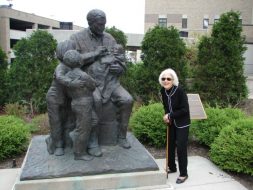
Heloisa Sabin at the Albert B, Sabin memorial at Children’s Hospital, 2010. Courtesy of the Winkler Center for the History of the Health Professions, University of Cincinnati, Cincinnati, Ohio
Heloisa Sabin
1917-2016
The Winkler Center was saddened to hear of the passing recently of Heloisa Sabin. Born, Heloisa Dunshee de Abranches, she married famous medical researcher and developer of the oral polio vaccine, Albert B. Sabin, in 1972.
Before her marriage to Dr. Sabin, she was women’s editor of a family-owned newspaper, Jornal do Brasil, in Rio de Janerio where she worked for 16 years. The Jornal was the largest daily newspaper in Rio at the time. She also studied at Columbia University in New York and held a law degree.
Asked what it was like being the wife of the famous research professor and virologist, “exciting,” she said. “I thought he was fascinating before I met him and I still think he is.” “Life with Dr. Sabin is certainly different from any other kind of life I could lead,” Mrs. Sabin asserted. “We are traveling all the time and I get to meet a lot of people who really enrich my life. Not only do we travel in the United States but we also travel in Europe and other countries where my husband has speaking engagements.” The Sabins not only traveled to numerous locales, but also resided at various times in New York, Washington D.C., Charleston, SC, Switzerland and Israel.
Heloisa became a steward of the Sabin legacy and a tireless activist in later life. Upon Albert Sabin’s death in 1993, she spent a majority of her time speaking out and fundraising to continue her late husband’s work in the study and improvement of immunizations, specifically in regard to Polio. In addition, she became a strong proponent of the use of animals in medical research, as the Polio vaccine her husband developed would not have been so successful had it not been for data gleaned from animal testing. She was a founding member of the Albert Sabin Research Institute, which advocates for global immunization to end all vaccine-preventable diseases.
She visited UC frequently, promoting ways to memorialize her husband’s accomplishments in the place where they occurred. Working with administration of what was then the Cincinnati Medical Heritage Center (now the Winker Center), she saw to it that Albert B. Sabin’s professional and personal papers came here in 1993.
In addition to her meaningful charitable contributions to the University, Mrs. Sabin played a role in the naming of the Children’s Hospital Sabin Center, Albert Sabin Way, and the Hauck Center for the Albert Sabin Archives. She also influenced the development of the Sabin exhibit in the Vontz Center and the Ohio Historical Marker dedicated to Sabin at the Vontz’s entrance.
The Winkler Center will miss Heloisa as will all those whose lives she touched.
If you are interested in researching the Sabin collection at the Winkler Center for the History of the Health Professions, please call 513.558.5120 or email chhp@ucmeil.uc.edu. To view an online inventory of the Albert B. Sabin Papers please visit Winkler-Albert B. Sabin Papers.
Works Used
Hembree, Linda. “Life with Noted Researcher Fascinating.” Spartanburg Herald (Spartanburg, SC). Wednesday, 3 December 1975. P. B3.
Marine, Steve. Correspondence with UC Foundation, Donor Files, Winkler Center for the History of the Health Professions, University of Cincinnati,
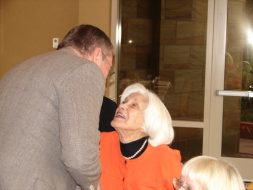
Heloisa Sabin greets visitors at the 50th Anniversary of Sabin Sundays in 2010. Courtesy of the Winkler Center for the History of the Health Professions, University of Cincinnati, Cincinnati, Ohio

Sabin with Executive Director of the Winkler Center, Steve Marine, at the 50th Anniversary of Sabin Sundays, 2010. Courtesy of the Winkler Center for the History of the Health Professions, University of Cincinnati, Cincinnati, Ohio